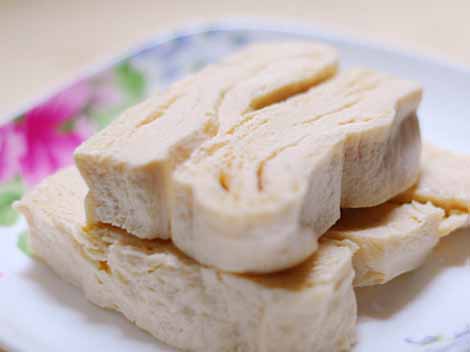Top 10 Famous Beijing Snacks
Beijing snacks include the snacks of many Chinese ethnic groups, such as the Han, Hui, Mongol and Manchurian, as well as imperial snacks from the Ming and Qing dynasties. They taste good and are inexpensive, which makes them very popular among average Beijingers.
The 10 most famous Beijing snacks are:
NO.10 Sweet ears (糖耳朵)
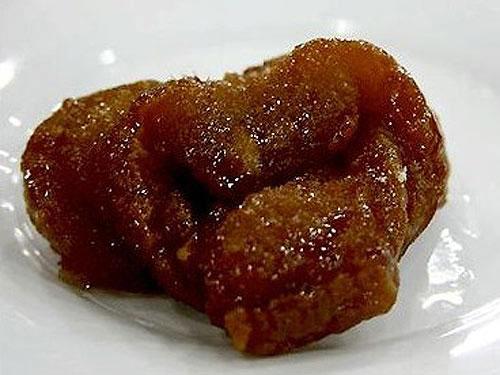 |
| Sweet ears |
Sweet ears, or tang er duo, is a fried sugar cake of Islamic origins that gets its name from its shape. Made of flour and sugar, it is served cold and tastes sweet and soft.
NO.9 Filled sausage (灌肠)
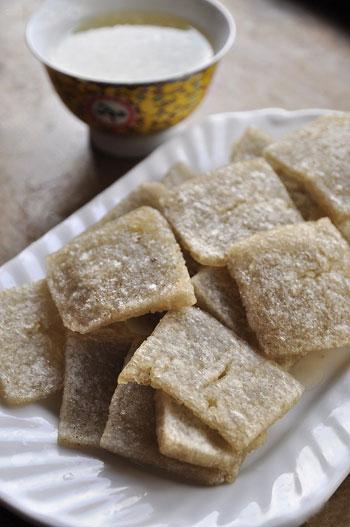 |
| Filled sausage |
Guan chang, or filled sausage, has been a popular snack in Beijing since the Ming Dynasty (1368-1644). Traditionally, the sausage, a prepared pork intestine, is stuffed with a paste of flour or starch mixed with spices. The sausage is then boiled and cut into cubes or slices to be fried. In some restaurants, minced pork is also used as stuffing. Little bamboo sticks, instead of chopsticks, are the traditional way of eating the filled sausages.
NO.8 Stir-fried starch knots (炒疙瘩)
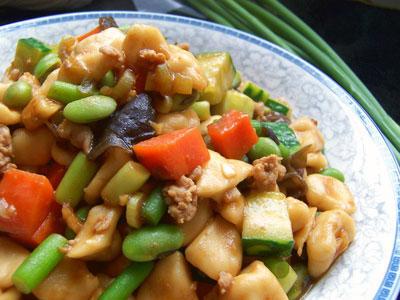 |
| Stir-fried starch knots |
Chao ge da, or stir-fried starch knots, is a kind of Chinese pasta. A traditional Muslim snack, it was invented almost 100 years ago. The dough, made from wheat and corn flour, is chopped, boiled in water and then immersed in cold water. Fresh beef or chicken is sliced and stir-fried with oil and seasonings and then stir-fried again with the starch knots and various seasonal vegetables. The final product is a colorful and refreshing dish.
NO.7 Fried wheaten pancake with fillings (褡裢火烧)
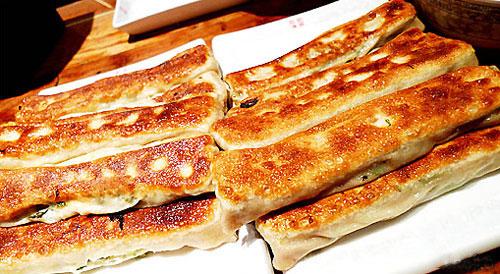 |
| Fried wheaten pancake with fillings |
Da lian huo shao, or fried wheaten pancake with filling, is a pan-fried roll filled with different stuffings, including pork with fennel, pork with cabbage, lamb with green onion and multiple vegetarian options. Its origins can be traced to the time of Emperor Guangxu (r. 1662-1722) of the Qing Dynasty. The pancakes are fried golden brown, but they remain very soft and delicious. Like dumplings, they usually go with vinegar. Beijing locals like to eat the pancakes while having a bowl of sweet and sour soup made of chicken blood and tofu.
NO.6 Rolling donkey (驴打滚)
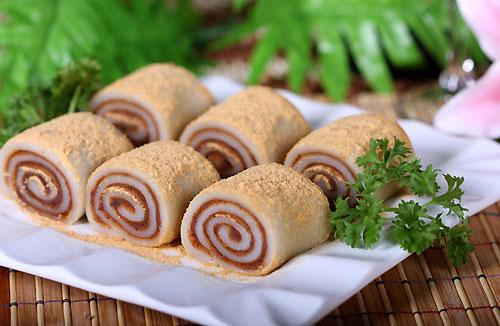 |
| Rolling donkey |
Lv da gun are steamed glutinous rice rolls filled with red bean paste or brown sugar that is then rolled and covered in a soybean flour crumble. Its origins can be traced to the Qing Dynasty. The cake, which has a yellowish color, is sweet and a little sticky, with a very nice bean flavor.
NO.5 Steamed rice cakes with sweet stuffing (艾窝窝)
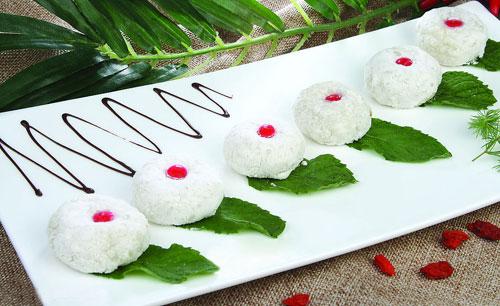 |
| Steamed rice cakes with sweet stuffing |
Ai wo wo, or steamed rice cakes with sweet stuffing, is made of glutinous rice or millet flour with sweet filling. It first appeared during the Yuan Dynasty (1279-1368) and was a favorite of the imperial families of the Ming Dynasty. The cake, which has a sticky texture and is white as snow, tastes sweet and comes with a variety of stuffings, such as ground rock sugar, hawthorn, sesame, green plum fruit or mashed Chinese jujube. Traditionally, it is eaten from the Lunar New Year to the end of summer, but it is now sold throughout the year.
NO.4 Fried beef tripe (爆肚)
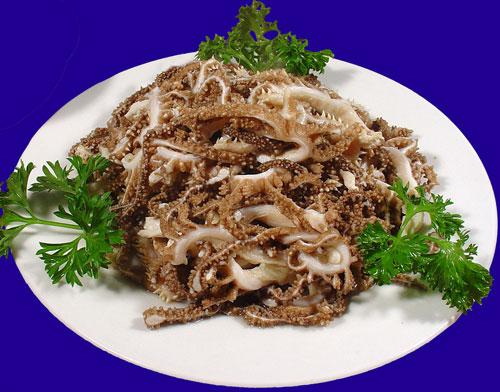 |
| Fried beef tripe |
Bao du, or fried beef tripe, has been a famous Beijing snack since the time of Emperor Qianlong (r. 1735-1795) of the Qing Dynasty. The snack is mostly made and sold by the Hui. After being cleaned and cut into slices, fresh beef tripe or lamb tripe is cooked in boiling water. It is often served with oil, sesame sauce, vinegar, chili oil, soy sauce, fermented tofu juice, coriander, spring onion and other seasonings. It is tender and crispy, and people often eat it with beer or other alcohol.
NO.3 Stewed pork liver (炒肝)
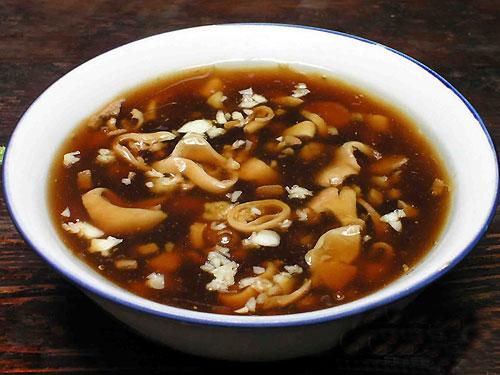 |
| Stewed pork liver |
Chao gan, or stewed liver, evolved from ao gan (stewed pork liver) and ao gei (stir-fried pork lung), both folk foods from the Song Dynasty (960-1279). The cleaned chitterlings are cut into pieces after being boiled in water. They are then stewed in mushroom soup with garlic sauce, chopped spring onion, chopped ginger and pork liver. Chicken soup and mashed garlic should be added before ready to serve. The soup is a glossy dark red and the pork liver and chitterlings are tender. Chao Gan used to be served with small dumplings, but now there is no particular way to eat it.
NO.2 Wheaten cake boiled in meat broth (卤煮火烧)
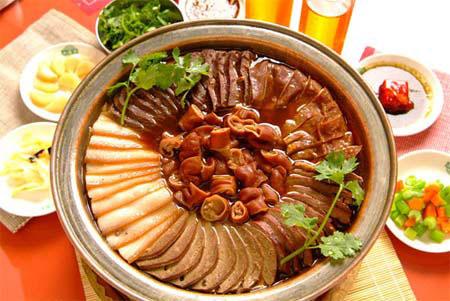 |
| Wheaten cake boiled in meat broth |
This traditional Beijing snack dates back 100 years to the Qing Dynasty (1644-1911). Baked wheaten bread, tofu, pork chop, chitterlings and pork lung are cut into pieces and then boiled in the preserved meat broth. It is served with mashed garlic, chili oil, vinegar, fermented tofu, chives and coriander. Called “lu zhu huo shao” in Chinese, the snack gained popularity among commoners in the olden days because meat was too expensive while the offal was a cheaper option.
NO.1 Mung bean milk (豆汁)
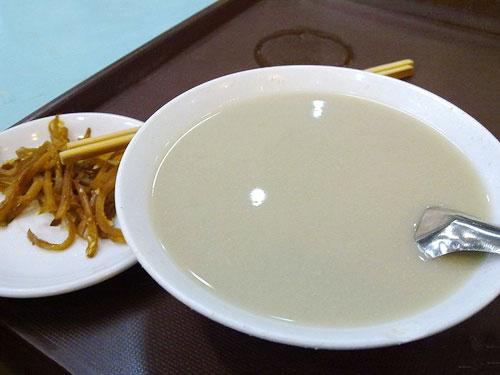 |
| Mung bean milk |
Mung bean milk is a by-product of cellophane noodle production and is similar to soy milk, exceot it is made from mung beans. It is a gray-green color and tastes slightly sour and sweet, with an egg-like smell. Although mung bean milk does not look or smell appetizing, most Beijingers love to drink it, especially in spring and winter. It is a very healthy food, with lots of protein, Vitamin C, fiber and sugar.
News&Opinion
 more
more- Panda Cubs Big Draw for Tourists to Sichuan
- China, India Hold Strategic Dialogue to Boost Ec...
- China, Russia Pledge to Further Military Coopera...
- Australia's Victoria State Premier Makes first O...
- CCTV Mid-Autumn Festival Gala Held in Jiangmen, ...
- Int'l Tourism Festival Opens in Beijing
- China backs NTC in Representing Libya at UN
- Shanghai Tourism Festival to Open





 print
print  email
email  Favorite
Favorite  Transtlate
Transtlate 